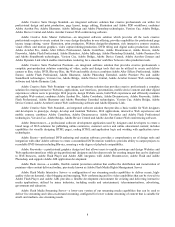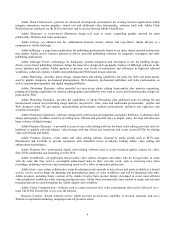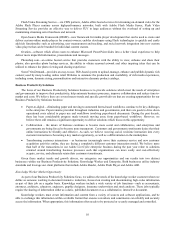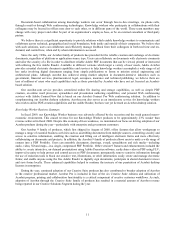Adobe 2009 Annual Report Download - page 18
Download and view the complete annual report
Please find page 18 of the 2009 Adobe annual report below. You can navigate through the pages in the report by either clicking on the pages listed below, or by using the keyword search tool below to find specific information within the annual report.18
Customers who use our Omniture solutions include marketing professionals such as marketing managers, online
marketing managers, search engine marketers, media managers, media buyers, marketing research analysts and the chief
marketing officer. Customers also include Web content editors, Web analysts and Web production managers. These
customers often are involved in workflows which utilize other Adobe products, such as our creative professional tools and
our Adobe Flash Platform client technologies.
We believe there are several key market trends creating opportunities for our Omniture business:
• Broad commercial utilization of the Internet — The Internet has fundamentally altered the way businesses and
consumers purchase and consumer goods and services. It has also redefined many business processes and has
created opportunities for new online businesses, as well as for existing offline businesses seeking to capitalize on
online initiatives. Because of this, businesses are investing in innovative online initiatives to increase sales, improve
customer service, enhance brand awareness, decrease time-to-market for their offerings, reduce fulfillment costs
and increase operational efficiency. We expect that the scope and scale of commercial Internet usage will continue
to increase. The roll-out of broadband networks and mobile networks, particularly in emerging geographic markets,
will contribute to the growth of Internet usage. Internet commerce should also continue to grow. Proliferation of
online marketing and customer response channels—such as mobile, online video, and social networks—will
continue to generate interactions that need to be measured and analyzed across channels.
• Need to measure and automate online business — In order to make informed decisions about priorities and
investments in online marketing and other commercial initiatives, we believe businesses require timely and accurate
measurement of customer behavior. The proliferation of Internet usage and the fact that nearly every user
interaction on a Website (or other digital medium such as mobile phone applications, set-top boxes, kiosks, point of
sale systems or any IP connected device) can be captured by the owner of the Website, or other digital medium,
have resulted in the creation of an unprecedented amount of data about how a business’ customers interact and
transact business with it. Businesses are increasingly realizing the benefit of using information gained from online
and other digital customer interactions to improve functional areas, such as sales, customer service, product
development, marketing, pricing, manufacturing and inventory management. The interactive and measurable nature
of Internet activity also enables businesses to determine how customers arrived at their online destinations, such as
Web and mobile sites, and to what extent the costs they incur to increase site traffic are generating sales.
• Opportunity to optimize online business — Measuring online behavior and automating the capture and analysis of
data are important for making informed business decisions. Businesses also need to leverage data to optimize the
results of their online business activities. For example, businesses have historically measured the success of their
online marketing programs by simple click-through rates or conversion rates, the latter being the percentage of
click-through users who make a purchase or otherwise engage in the desired customer action during the online
session. However, the effectiveness of online marketing can be optimized by analyzing and acting on deeper
information, such as repeat visits, transactions generated, registrations, traffic pathways (various paths of online
visitor traffic flow), time spent and quality of interaction (engagement), eventual conversion (desired customer
action taken in subsequent visits) or success over time (lifetime value of customer) as well as comparing the relative
effectiveness of different marketing channels (attribution). Business success metrics can also vary based on the
industry or vertical market—for example, media companies optimize subscriptions and online advertising revenue,
whereas retailers and ecommerce companies focus on registrations and online purchases. Online businesses utilize
a large and growing number of complex and diverse communication channels to market to customers, including
display advertising, paid and natural search advertising, e-mail, social media marketing, affiliate marketing, blogs,
podcasts, video, RIAs and comparison shopping engines, as well as traditional offline initiatives. The emergence of
multi-channel marketing initiatives, which combine traditional offline marketing initiatives such as television, print,
magazine, newspapers, radio and catalog with online marketing initiatives, makes the measurement and analysis of
online behavior more challenging, but presents additional opportunities to optimize results. For example, businesses
want to measure and understand the impact of their advertising initiatives across all these channels, not only to
determine how much credit should be given to a particular channel and to understand cross-promotional
effectiveness, but more importantly to optimize search spending, make adjustments in the way channels are utilized
and align the amount of resources that are allocated to each of them.
For many years, Adobe has provided creative tools and ubiquitous clients via the Adobe Flash Platform to help
customers create and deliver engaging content and experiences. Given the market trends described above, we believe the
combination of our tools and clients with Omniture’s capabilities will help customers to more efficiently and effectively
measure, analyze and optimize those experiences—creating a complete feedback loop. With this broad platform, we believe
























